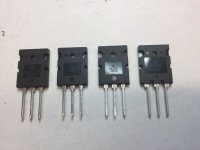Hi. does anyone know if the are any difference between the top and bottom transistors? one does have an X in front? Thanks.

No they came out of Arcam amps. Just need to know if I can replace the bottom ones with the top ones. Thanks.
Top left has a date code type I have hot seen before. Centre leg (collector) is narrow - never from ON = Fake
Top right XNJL prefix? Have no idea if this part is a replacement for the real NJLxxxx if from ON.
Maybe you need to do your own research to be sure.
Top right XNJL prefix? Have no idea if this part is a replacement for the real NJLxxxx if from ON.
Maybe you need to do your own research to be sure.
Sadly, the same way that reputable parts houses can sometimes get fake components; unless they can prove provenance all the way back to the primary manufacturer, someone, somewhere can insert fakes into the supply chain. This problem has become worse in recent years, not better, so it pays to be suspicious.These were installed by the manufacturer in the AVR380 so how can they be fake?
Top left looks fake. Center leg is smaller and the three molding dots on the face are much larger and the print is smaller.
If we assume that Onsemi assembles all their power transistors in the one facility by the same subcontractor, then there may be a reason to suspect a fake. Is that the case though, with a lot of production having moved offshore to acquisitions like Fairchild and what of Sanyo's former product line?
These are unique transistors with dissimilar temperature reference diode numbers - possibly with different leadframes, accordingly but surely, you could begin with diode checks to see how far from any working original parts, their expected measurements are. Bob Cordell has made quite a study of these ThermalTraks, maybe there's also some clues as to why transistors don't stay the same forever, at his website, in books and posts here on this topic.
These are unique transistors with dissimilar temperature reference diode numbers - possibly with different leadframes, accordingly but surely, you could begin with diode checks to see how far from any working original parts, their expected measurements are. Bob Cordell has made quite a study of these ThermalTraks, maybe there's also some clues as to why transistors don't stay the same forever, at his website, in books and posts here on this topic.
Please refer to official technical information
https://www.onsemi.com/download/data-sheet/pdf/njl0281d-d.pdf
CQ=Assembly Location according to documents this is probably the Philippines
0616 06 is the year 2006
small marking font
According to the drawing, the leads have the same size and shape



https://www.onsemi.com/download/data-sheet/pdf/njl0281d-d.pdf
CQ=Assembly Location according to documents this is probably the Philippines
0616 06 is the year 2006
small marking font
According to the drawing, the leads have the same size and shape
CQ This is a localization of production in the Philippines
SP This is the localization of production in Korea
SP This is the localization of production in Korea
From 2007 datasheet diode voltage at 25C and 1mA is around 0.5V +/-20mV. A DMM diode test should read around 480mV at 25C.... you could begin with diode checks to see how far from any working original parts, their expected measurements are.
Bob measured 570mV at 12.5mA at 25C (Book Fig 17.30 2nd Ed) and datasheet is just over 600mV.
I have one new ThermalTrak diode that's way out of spec. It reads 120mV higher than all my others (and the datasheet). It is NJL1302D marked CQ0527.
It was supplied in a kit (Silicon Chip Aug 2008 kit KC5470) and its complement shown which has a similar date but its diode was within spec.
This kit was withdrawn after some amps failed due to excessive idle current (since they did not use a Vbe multiplier or trimpot, relying on the ThermalTrak diodes being consistent). The next SC version amp had a quiescent trimpot.
I didn't find any explanation from OnSemi or SC as to why some ThermalTrak diodes were so far out of spec. and I haven't heard of any later out of spec diodes. Has anyone else here come across any genuine ThermalTraks that had diodes way out of spec?
BTW Bob says the diode die used in the ThermalTrak is the MUR120.
If anyone wants to disolve the case of my one to see what size diode chip is used then I can send it. Maybe someone writing a history of amp kit failures?
On Semi is what the discrete part of Motorola became, and Motorola used the X prefix to designate prototype/pre-production parts. It is entirely possible that Arcam were supplied with early parts before full production was running, but surprising that they used them in production amplifiers. That would also explain differences in the package too.
These are the boundary values of the graph. This diode should be used at a current of 10mA.diode voltage at 25C and 1mA is around 0.5V +/-20mV
I think the TT idea fell well short of expectations - even Bob Cordell remarked that the diodes should have been integrated onto the power transistor chip, not a separate die. I dont know what the yield impact between the two approaches would be, but I would assume an integrated diode would be higher yield. Maybe you make a single die with an integrated diode and then during wafer probe, if the diode is out of spec, those chips go into non thermal trak devices. for themal sensing, you really only need a very small diode which would be much smaller than the bond out pads.
- Home
- Amplifiers
- Solid State
- Can I just ask the difference between these output Thermaltrak transistors?
